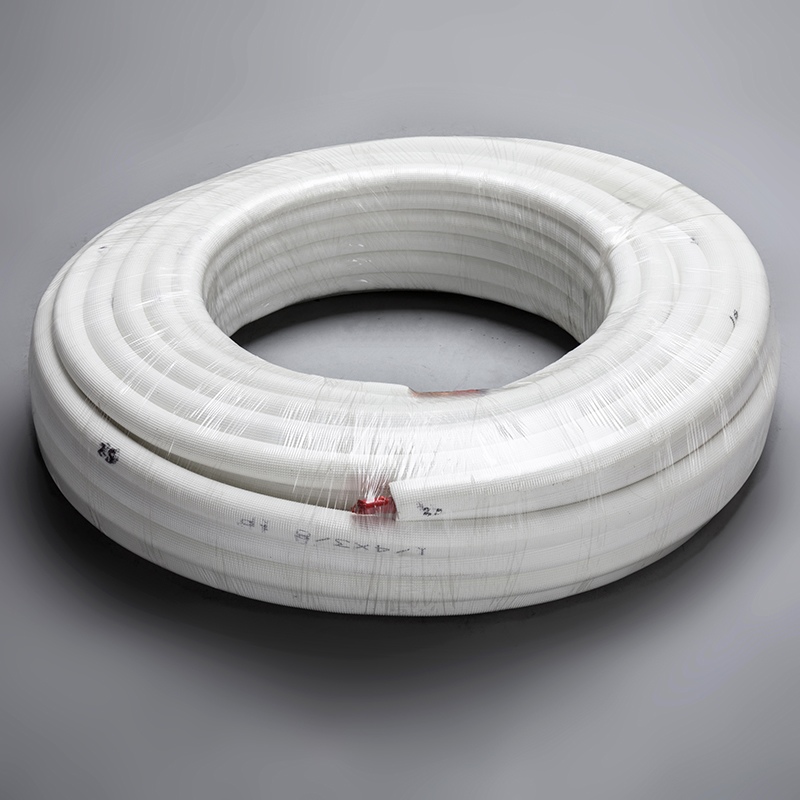What Makes Copper Pipes Ideal for Air Conditioning Units

Refrigerant copper pipes are key parts of air conditioning systems. They transfer heat well because of their high thermal conductivity, between 300 and 400 W/(m•K). Small refrigerant copper tubes, as tiny as 5mm, lower internal space by 41%. This makes them much more energy-efficient. New ideas like MicroGroove technology add grooves inside the refrigerant copper pipes. These grooves create more surface area to move heat faster. These features make refrigerant copper pipes small but powerful. They save energy and keep your home or office cool.
Key Takeaways
Copper pipes are strong and do not rust, lasting a long time in air conditioners.
They transfer heat well, making air conditioners use less energy and cost less.
Flexible copper pipes are easy to install in small spaces. This lowers leak chances and makes systems work better.
Picking the right copper pipe type (K, L, or M) is important for handling pressure and specific uses.
Copper pipes are good for the environment because they can be recycled without losing quality, helping HVAC systems stay eco-friendly.
Key Properties of Refrigerant Copper Pipes
Durability and Corrosion Resistance
Copper pipes are very strong and last a long time. They don’t rust easily, which helps prevent leaks and keeps systems working well. When copper meets air, it creates a thin layer that protects it from more damage. This natural shield helps the pipes stay useful even in tough conditions.
The table below shows why copper pipes are durable and resist rust:
Evidence Description | Key Points |
|---|---|
Corrosion Resistance | Stops leaks and keeps systems working properly. |
Protective Oxide Layer | Forms in air to stop further damage to copper. |
Environmental Impact | Works differently in wet or acidic surroundings. |
Temperature Range | Handles -40°C to 120°C with safe refrigerants. |
Purity Levels | Pure copper makes a stronger protective layer. |
Copper pipes work well in extreme temperatures, from -40°C to 120°C. They also resist damage from moisture and acids, making them last longer.
High Thermal Conductivity
Copper pipes are great at moving heat quickly. This is very important for air conditioners. Copper can transfer heat better than most materials, with a range of 300 to 400 W/(m•K).
This ability helps refrigerants absorb and release heat fast. It makes air conditioners use less energy while keeping spaces cool. Using copper pipes ensures your system works well and saves energy.
Smooth Inner Surface for Efficient Refrigerant Flow
The inside of copper pipes is smooth, which helps refrigerants flow easily. Less friction means refrigerants move faster and with fewer problems. This improves the system’s efficiency and avoids pressure drops.
Studies show smooth copper pipes help refrigerants and nanolubricants flow better. Without extra fins inside, smooth pipes improve heat transfer. Scientists also use models to study how smooth pipes reduce pressure issues.
The smooth surface also stops dirt or debris from building up inside. This keeps the system running well and prevents blockages. Combined with copper’s strength, this feature makes air conditioners reliable and efficient for a long time.
Flexibility and Pressure Handling
Copper pipes are flexible, making them simple to install. You can bend them easily without breaking. This helps fit them into tight spaces or around obstacles. Fewer fittings are needed, which lowers leak risks and boosts system efficiency.
Tip: Flexible copper pipes work well in older buildings. Tight spaces make rigid materials harder to use.
Copper pipes also handle high pressure very well. Air conditioners need strong pipes because refrigerants move under pressure. Copper doesn’t crack or deform, keeping the system safe and working properly.
Here’s why flexibility and pressure handling matter for air conditioners:
Flexibility Benefits:
Easy to install in tricky layouts.
Fewer joints mean fewer weak spots.
Quick to adjust during repairs or maintenance.
Pressure Handling Advantages:
Stops pipes from failing under high pressure.
Keeps refrigerant flowing smoothly for better performance.
Makes the air conditioner last longer.
Copper pipes stay strong over time. Some materials weaken with repeated pressure, but copper stays reliable. This makes it a great choice for HVAC systems.
Note: Always check if copper pipes meet your system’s pressure needs. This ensures they work safely and efficiently.
Types of Copper Pipes in Air Conditioning Systems
Picking the right copper pipe is important for air conditioners. Each type has special features for different uses. Knowing these differences helps you choose the best one for your system.
Type K Copper Pipes
Type K pipes are the thickest and strongest option. Their thick walls handle high pressure, making them great for tough jobs. These pipes are often used underground or in places needing extra strength.
They are perfect for areas with harsh conditions or lots of moisture. Their durability ensures they last a long time, even in hard environments.
Type L Copper Pipes
Type L pipes are strong but more flexible than Type K pipes. They have medium-thick walls, which handle high pressure but are easier to work with. These pipes are common in homes and businesses.
If you’re setting up a new air conditioner, Type L pipes are a good choice. They are durable and work well for most standard systems. Their thickness makes them simpler to install and maintain.
Type M Copper Pipes
Type M pipes are the thinnest of the three types. They are made for low-pressure systems, like basic home air conditioners. These pipes are lightweight and cost less, making them great for saving money.
While not as strong as Type K or L, Type M pipes still work well for certain uses. If your system doesn’t need high pressure, these pipes are a good, affordable option.
Type | Wall Thickness | Pressure Tolerance | Applications |
|---|---|---|---|
K | Thick | High | Tough jobs, underground use |
L | Medium-thick | High | Homes, businesses |
M | Thin | Low | Low-pressure home systems |
By learning about copper pipe types, you can make smart choices. Each type has its own strengths, so you can find the right one for your needs.
Soft Copper vs. Hard Copper Pipes
When picking copper pipes for air conditioners, there are two main types: soft copper and hard copper. Each type works best for certain jobs.
Soft copper pipes are very bendable. You can shape them easily, so they’re great for tight spaces or tricky layouts. This flexibility means fewer extra parts are needed, which lowers the chance of leaks. Soft copper is often used in refrigerant lines where bending is important. But because it’s softer, it can get damaged more easily. Handle it carefully during setup and repairs.
Hard copper pipes are strong and stiff. They work well for straight setups where strength matters most. These pipes don’t bend or change shape easily and can handle higher pressure. This makes them a good choice for long-lasting use. Hard copper is often used in open areas or places where the pipe needs to stay firm under stress. But since it’s not flexible, you’ll need extra parts to go around corners, which might take more time and cost more.
Tip: Use soft copper for short, bendable connections and hard copper for long, straight setups.
Here’s a simple comparison to help you choose:
Feature | Soft Copper Pipes | Hard Copper Pipes |
|---|---|---|
Flexibility | Very bendable | Not bendable |
Durability | Okay | Very strong |
Installation Ease | Easy in tight spots | Best for straight lines |
Common Uses | Refrigerant lines | Open or long setups |
Knowing these differences helps you pick the right pipe for your air conditioner.
Benefits of Copper Pipes in HVAC Systems
Energy Efficiency and Heat Transfer
Copper pipes help air conditioners save energy. They move heat quickly because of their high thermal conductivity. This helps refrigerants absorb and release heat easily. As a result, less energy is needed to cool or heat spaces. Using copper pipes lowers energy bills while keeping performance steady.
Smaller copper tubes in modern systems improve energy savings even more. These tubes need less refrigerant to work, cutting costs and reducing environmental harm. The smooth inside of copper pipes also helps refrigerants flow better. This avoids pressure problems and keeps the system efficient.
Tip: Adding insulation to copper pipes can stop heat loss and save more energy.
Longevity and Reliability
Copper pipes last a long time, making them dependable for HVAC systems. They resist rust, which stops leaks and keeps systems working longer. Copper stays strong even in extreme heat or high pressure. This ensures safe and efficient operation for many years.
Copper pipes are also flexible, making installation and repairs easier. This reduces the chance of damage during setup. They are a smart choice for homes and businesses. With insulation, copper pipes handle tough conditions and keep working well over time.
Note: Check your HVAC system regularly to keep copper pipes in good shape and extend their life.
Environmental Sustainability and Recyclability
Copper pipes are eco-friendly and good for the environment. They last a long time, so they don’t need to be replaced often. Old copper pipes can be recycled without losing quality, reducing waste and saving resources.
Smaller copper coils use less material, making products lighter and easier to manage. This lowers production costs and reduces environmental impact. Also, smaller coils need less refrigerant, which saves money and is better for the planet.
Benefit | Description |
|---|---|
Energy Efficiency | Small copper tubes improve energy use in air conditioners. |
Reduced Material Usage | Smaller coils use less material, making them lighter and easier to handle. |
Less Refrigerant | Smaller coils need less refrigerant, cutting costs and helping the environment. |
Durability | Copper pipes resist rust and last long, supporting sustainability. |
Choosing copper pipes for HVAC systems helps the environment. They save energy, lower costs, and provide reliable cooling and heating.
Compatibility with Modern Refrigerants
Copper pipes work well with today’s refrigerants. They are a great choice for air conditioners. As refrigerants change to meet environmental rules, materials must adjust too. Copper pipes are perfect because of their special qualities.
Copper transfers heat quickly, helping refrigerants move better. It has a heat transfer rate of 223 BTU/hour per square foot per degree Fahrenheit. This makes air conditioners work faster and more efficiently.
Copper pipes can handle high pressure, up to 250 PSI at 100°F. They stay strong in extreme heat or cold. This keeps air conditioners running smoothly without breaking.
Copper doesn’t rust easily, unlike other materials. It doesn’t need extra coatings to stop corrosion. This saves money on repairs and makes systems last longer. Copper pipes work well indoors and outdoors without damage.
Here’s why copper pipes are great for modern refrigerants:
Feature | Description |
|---|---|
Heat Transfer | Moves heat fast at 223 BTU/hour per square foot per degree Fahrenheit. |
Pressure Strength | Handles up to 250 PSI at 100°F, staying reliable in tough conditions. |
Rust Resistance | Naturally resists rust, cutting maintenance costs and lasting longer. |
Copper pipes also have practical benefits:
They are strong and work for homes and businesses.
They need little upkeep because they resist rust.
They match well with modern refrigerants for better energy use.
Adding insulation to copper pipes stops heat loss. This keeps refrigerants at the right temperature as they flow. Insulated pipes save energy and make systems last longer.
Choosing copper pipes for air conditioners is smart. They work well with new refrigerants, save energy, and need less care. Copper pipes are a reliable and efficient option for cooling systems.
Applications in Air Conditioning Systems
Copper pipes are important in air conditioning systems. Their special features make them great for cooling and heating. Below are key ways copper pipes are used.
Refrigerant Flow Lines
Copper pipes are crucial for refrigerant flow lines. These lines move refrigerants between parts like the compressor, condenser, and evaporator. The smooth inside of copper pipes helps refrigerants flow easily. This reduces pressure problems and improves how the system works.
Copper’s ability to transfer heat quickly makes cooling and heating more effective. It also uses less energy. Insulated copper pipes stop heat from escaping, keeping refrigerants at the right temperature. This improves efficiency and helps the HVAC system last longer.
Suction and Discharge Lines
Suction and discharge lines are vital for air conditioners. Copper pipes are often used because they handle high pressure and extreme temperatures well. The suction line moves low-pressure refrigerant vapor to the compressor. The discharge line carries high-pressure vapor to the condenser.
Copper pipes make sure refrigerants move safely and efficiently. They are strong and resist leaks, which keeps the system working well. Flexible copper pipes are helpful in tight spaces. They can bend without breaking, making installation easier.
Heat Exchangers and Condensers
Copper pipes are common in heat exchangers and condensers because they transfer heat quickly. These parts move heat between refrigerants and air or water. Copper’s fast heat transfer makes it perfect for these jobs.
Studies show copper heat exchangers save energy and improve performance. For example:
Study | Findings |
|---|---|
Suleiman et al. | Heat pipe exchangers save energy with more nanoparticles. |
Abdelaziz et al. | Copper heat pipes cut energy use by 30% and last 20 years. |
Sukarno et al. | Heat exchangers save 46% energy and lower air temperature by 9.4°C. |
These studies show why copper is great for heat exchangers and condensers. Using copper saves energy, improves air quality, and makes HVAC systems last longer.
Maintenance and Repairs
Taking care of copper pipes keeps your air conditioner working well. Check them often to find problems early. This stops big repairs from being needed. Look for leaks, rust, or worn-out spots on the pipes. These issues can make the system less efficient and slow down refrigerant flow.
Cleaning the pipes is important for smooth operation. Dirt inside can block refrigerants and hurt performance. Use special tools to clean the inside of the pipes. This helps refrigerants move better and avoids pressure problems.
Insulated copper pipes need extra attention. Insulation stops heat loss and protects pipes from temperature changes. Check insulation for damage or wear. Replace it if it’s worn out to keep the system efficient.
If repairs are needed, use strong materials for lasting results. Soft copper pipes are good for tight spaces. Hard copper pipes work better for straight sections. Always pick the right pipe type for the job.
Tip: Have a professional check your system every year. They can find hidden problems and make sure refrigerant levels are correct.
Here’s a simple checklist for keeping copper pipes in good shape:
Look for leaks or rust on the pipes.
Clean the inside to remove dirt or debris.
Check insulation and replace it if damaged.
Use the right type of copper pipe for fixes.
Get professional inspections regularly.
Following these steps helps your air conditioner last longer and work better.
Copper pipes are key parts of air conditioners. They are strong, last long, and are better than other materials. Copper doesn’t rust easily and stays tough under pressure. It helps refrigerants move smoothly, keeping cooling systems working well.
Copper pipes save energy and are good for the environment. They hold temperatures better than other materials, cutting energy waste. Old copper can be recycled without losing quality, making it eco-friendly. Adding insulation to copper pipes improves their performance by keeping refrigerants at the right temperature.
Feature | Copper Pipes | Other Materials |
|---|---|---|
Rust Resistance | Doesn’t rust in most conditions | Can crack or leak |
Strength | Stays strong under pressure | Weaker and may break |
Lifespan | Works well for many years | Doesn’t last as long |
Recycling | Recycled without losing quality | Often reused with lower quality |
Knowing why copper pipes are great helps you pick the best option. They are reliable, eco-friendly, and work well for a long time.
FAQ
Why are copper pipes better for air conditioners?
Copper pipes don’t rust, move heat well, and handle pressure. They last longer than other materials and can be recycled. Their smooth inside helps refrigerants flow easily, making systems work better.
Can copper pipes handle very hot or cold temperatures?
Yes, copper pipes work in temperatures from -40°F to 248°F. They stay strong and don’t break in heat or cold. This makes them dependable for air conditioners in all climates.
How do I take care of copper pipes in my HVAC system?
Check pipes often for leaks or rust. Clean them to remove dirt and inspect insulation for damage. Replace worn parts quickly. Have a professional check the system yearly to keep refrigerant levels right and ensure it works well.
Are copper pipes good for modern refrigerants?
Yes, copper pipes work great with today’s refrigerants. They move heat fast and don’t rust, helping refrigerants flow smoothly. Copper is strong enough for high-pressure refrigerants, making it perfect for energy-saving air conditioners.
Can old copper pipes be reused?
Yes! Copper pipes can be recycled completely without losing quality. Recycling cuts waste and saves resources, making copper a green choice for HVAC systems. Recycled copper can be used again in new systems or other products.
See Also
The Benefits Of Using Copper Pipes In Air Conditioning
How Pure Copper Pipes Enhance Air Conditioning Efficiency
Key Advantages Of Copper Pipes In Air Conditioning Systems


